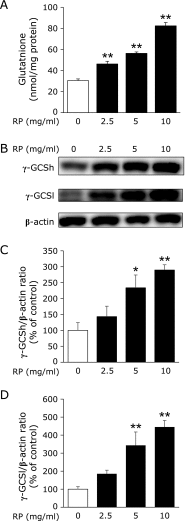Hepatoprotective effects of rice-derived peptides against acetaminophen-induced damage in mice
- PMID: 28366990
- PMCID: PMC5370527
- DOI: 10.3164/jcbn.16-44
Hepatoprotective effects of rice-derived peptides against acetaminophen-induced damage in mice
Abstract
Glutathione, the most abundant intracellular antioxidant, protects cells against reactive oxygen species induced oxidative stress and regulates intracellular redox status. We found that rice peptides increased intracellular glutathione levels in human hepatoblastoma HepG2 cells. Acetaminophen is a commonly used analgesic. However, an overdose of acetaminophen causes severe hepatotoxicity via depletion of hepatic glutathione. Here, we investigated the protective effects of rice peptides on acetaminophen-induced hepatotoxicity in mice. ICR mice were orally administered rice peptides (0, 100 or 500 mg/kg) for seven days, followed by the induction of hepatotoxicity via intraperitoneal injection of acetaminophen (700 mg/kg). Pretreatment with rice peptides significantly prevented increases in serum alanine aminotransferase, aspartate aminotransferase, and lactate dehydrogenase levels and protected against hepatic glutathione depletion. The expression of γ-glutamylcysteine synthetase, a key regulatory enzyme in the synthesis of glutathione, was decreased by treatment with acetaminophen, albeit rice peptides treatment recovered its expression compared to that achieved treatment with acetaminophen. In addition, histopathological evaluation of the livers also revealed that rice peptides prevented acetaminophen-induced centrilobular necrosis. These results suggest that rice peptides increased intracellular glutathione levels and could protect against acetaminophen-induced hepatotoxicity in mice.
Keywords: acetaminophen; glutathione; liver injury; rice-derived peptide.
Conflict of interest statement
No potential conflicts of interest were disclosed.
Figures





Similar articles
-
Sake lees hydrolysate protects against acetaminophen-induced hepatotoxicity via activation of the Nrf2 antioxidant pathway.J Clin Biochem Nutr. 2017 Nov;61(3):203-209. doi: 10.3164/jcbn.17-21. Epub 2017 Sep 5. J Clin Biochem Nutr. 2017. PMID: 29203962 Free PMC article.
-
Hepatoprotective Activity of Yellow Chinese Chive against Acetaminophen-Induced Acute Liver Injury via Nrf2 Signaling Pathway.J Nutr Sci Vitaminol (Tokyo). 2020;66(4):357-363. doi: 10.3177/jnsv.66.357. J Nutr Sci Vitaminol (Tokyo). 2020. PMID: 32863309
-
Protection afforded by pre- or post-treatment with 4-phenylbutyrate against liver injury induced by acetaminophen overdose in mice.Pharmacol Res. 2014 Sep;87:26-41. doi: 10.1016/j.phrs.2014.06.003. Epub 2014 Jun 18. Pharmacol Res. 2014. PMID: 24951965
-
Auriculatone Sulfate Effectively Protects Mice Against Acetaminophen-Induced Liver Injury.Molecules. 2019 Oct 9;24(20):3642. doi: 10.3390/molecules24203642. Molecules. 2019. PMID: 31600996 Free PMC article.
-
Rutaecarpine Protects against Acetaminophen-Induced Acute Liver Injury in Mice by Activating Antioxidant Enzymes.Antioxidants (Basel). 2021 Jan 10;10(1):86. doi: 10.3390/antiox10010086. Antioxidants (Basel). 2021. PMID: 33435214 Free PMC article.
Cited by
-
Peptides as carriers of active ingredients: A review.Curr Res Food Sci. 2023 Sep 17;7:100592. doi: 10.1016/j.crfs.2023.100592. eCollection 2023. Curr Res Food Sci. 2023. PMID: 37766891 Free PMC article. Review.
-
Protective Effects of Rice Peptide Oryza Peptide-P60 against Oxidative Injury through Activation of Nrf2 Signaling Pathway In Vitro and In Vivo.ACS Omega. 2020 May 26;5(22):13096-13107. doi: 10.1021/acsomega.0c01016. eCollection 2020 Jun 9. ACS Omega. 2020. PMID: 32548495 Free PMC article.
-
Sake lees hydrolysate protects against acetaminophen-induced hepatotoxicity via activation of the Nrf2 antioxidant pathway.J Clin Biochem Nutr. 2017 Nov;61(3):203-209. doi: 10.3164/jcbn.17-21. Epub 2017 Sep 5. J Clin Biochem Nutr. 2017. PMID: 29203962 Free PMC article.
-
Galangin Nanoparticles Protect Acetaminophen-Induced Liver Injury: A Biochemical and Histopathological Approach.Evid Based Complement Alternat Med. 2022 Aug 10;2022:4619064. doi: 10.1155/2022/4619064. eCollection 2022. Evid Based Complement Alternat Med. 2022. PMID: 35990838 Free PMC article.
-
Isolation of the hemeoxygenase-1 inducer from rice-derived peptide.J Clin Biochem Nutr. 2022 Jul;71(1):41-47. doi: 10.3164/jcbn.21-125. Epub 2022 Jan 25. J Clin Biochem Nutr. 2022. PMID: 35903607 Free PMC article.
References
-
- Meister A, Anderson ME. Glutathione. Annu Rev Biochem. 1983;52:711–760. - PubMed
-
- Reid M, Jahoor F. Glutathione in disease. Curr Opin Clin Nutr Metab Care. 2001;4:65–71. - PubMed
-
- Witschi A, Reddy S, Stofer B, Lauterburg BH. The systemic availability of oral glutathione. Eur J Clin Pharmacol. 1992;43:667–669. - PubMed
-
- Laskin DL, Pilaro AM. Potential role of activated macrophages in acetaminophen hepatotoxicity. I. Isolation and characterization of activated macrophages from rat liver. Toxicol Appl Pharmacol. 1986;86:204–215. - PubMed
-
- Hazai E, Vereczkey L, Monostory K. Reduction of toxic metabolite formation of acetaminophen. Biochem Biophys Res Commun. 2002;291:1089–1094. - PubMed
LinkOut - more resources
Full Text Sources
Other Literature Sources
Molecular Biology Databases
Research Materials

